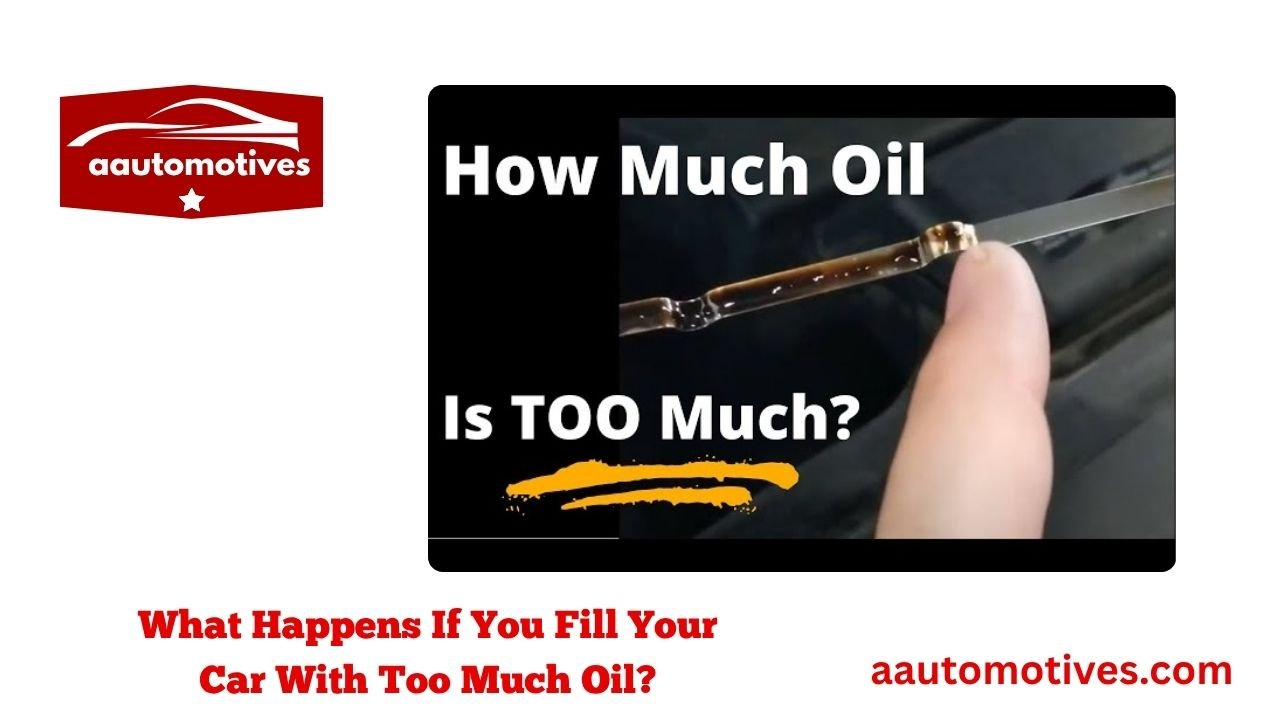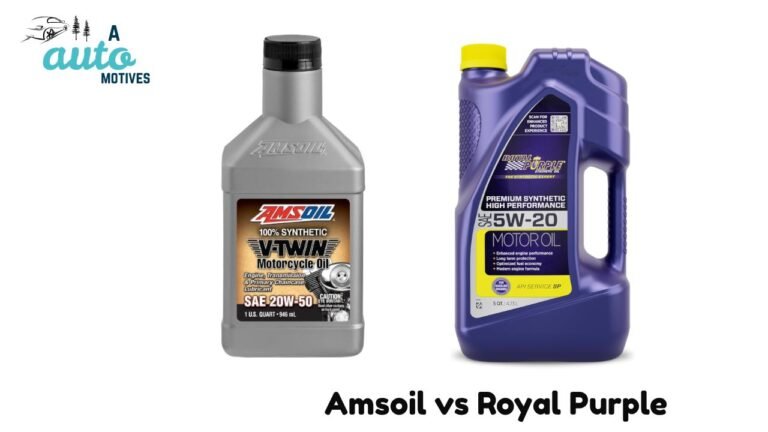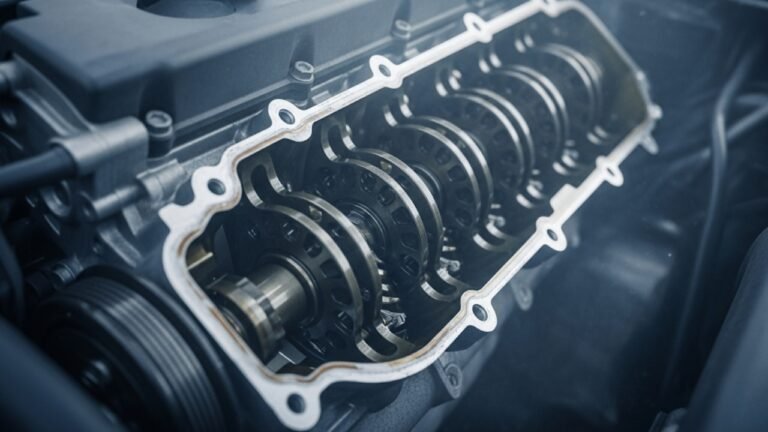What Happens If You Fill Your Car With Too Much Oil?

Ever heard the phrase, “Too much of anything is bad”? That’s especially true when it comes to car maintenance. One mistake I made during my early driving days was thinking more oil meant better engine health. I poured it in like I was seasoning food—just a little more for luck. That “little more” cost me a couple hundred bucks and a whole weekend without my car.
So, what happens if you fill your car with too much oil? Trust me, it’s not pretty. It might seem harmless, but overfilling oil can lead to serious problems—engine damage, smoke, misfires, or worse. Whether you’re a DIY oil changer or someone who double-checks everything at the shop, this article will break it all down for you.
Let’s dive in and explore the effects, causes, symptoms, and fixes for overfilling engine oil—without the jargon and stress.
In This Article
- 1 Why Proper Oil Level Matters More Than You Think
- 2 What Actually Happens Inside the Engine When Oil Is Overfilled
- 3 Symptoms of Too Much Oil in Your Car
- 4 How to Check If You Overfilled Your Engine Oil
- 5 How to Fix Overfilled Oil Without Damaging the Engine
- 6 Quick Reference Table: Too Much Oil Symptoms vs Fixes
- 7 How Much Is Too Much Oil? Don’t Guess—Measure
- 8 Long-Term Damage: What Happens If You Keep Overfilling Oil?
- 9 A True Story: I Overfilled Oil—And Paid the Price
- 10 How to Prevent Overfilling Oil in the First Place
- 11 Frequently Asked Questions (FAQs)
- 11.1 1. How much oil is too much in a car?
- 11.2 2. Can overfilling oil cause permanent damage?
- 11.3 3. Will too much oil burn off on its own?
- 11.4 4. How can I safely remove excess oil?
- 11.5 5. What if my mechanic overfilled it?
- 11.6 6. Does overfilled oil always cause visible symptoms?
- 11.7 7. Is synthetic oil more forgiving with overfilling?
- 11.8 8. Can overfilling oil trigger the check engine light?
- 12 Final Thoughts: Love Your Engine, Respect the Line
Why Proper Oil Level Matters More Than You Think
Your engine oil is like the blood in your veins. Not too much. Not too little. Just right. It keeps everything running smoothly, lubricating parts, reducing friction, and managing heat. When you have too much oil in your car, the oil level rises above what your engine is designed to handle.
Here’s why that’s a problem:
-
Oil gets whipped into foam by moving parts.
-
Foam doesn’t lubricate well.
-
Poor lubrication = more friction and overheating.
-
That heat can warp parts, cause seals to break, or fry your catalytic converter.
Think of it like pouring too much milk into your blender. Instead of a creamy smoothie, you get a mess that spills everywhere. That’s exactly what too much oil does—it creates chaos inside your engine instead of calm, clean performance.
What Actually Happens Inside the Engine When Oil Is Overfilled
So, what happens if you fill your car with too much oil from a technical perspective? Picture your engine as a tightly packed, highly coordinated orchestra. Every part has its timing. The crankshaft, one of the most important parts, spins like crazy right above the oil pan.
When you overfill, the crankshaft dips into the oil and starts whipping it like a blender. This causes air to mix with the oil—turning it into a bubbly, frothy mix.
And here’s the kicker:
Foamy oil can’t coat parts properly.
That means:
-
Piston rings get dry.
-
Bearings wear down.
-
The engine runs hotter.
-
You risk a blown gasket or a warped cylinder head.
It’s like trying to run a marathon while breathing through a straw. You might move forward, but every second causes more damage.
Symptoms of Too Much Oil in Your Car
Wondering if you’ve already made this mistake? Don’t worry—I’ve been there. Whether you overfilled it during a DIY oil change or a rushed visit to a mechanic, the signs show up quickly if you know where to look.
Here are some common symptoms of too much oil in a car:
-
White smoke coming out of the exhaust
-
Burning oil smell while driving
-
Engine misfires or poor performance
-
Oil leaks under your car
-
Check engine light suddenly comes on
-
A rough or knocking engine noise
-
Sudden loss of power or stalling
Most of these are your car’s way of screaming, “Hey! I can’t breathe in here!” If you notice any of these symptoms right after an oil change, it’s worth checking your dipstick right away.
How to Check If You Overfilled Your Engine Oil
You don’t need to be a mechanic to figure this out. Here’s a simple way to see if there’s too much oil in your car.
Step-by-Step:
-
Park on level ground and let your car cool.
-
Pop the hood and find the dipstick (usually a bright color like yellow or orange).
-
Wipe it clean with a rag.
-
Reinsert and pull it out again.
-
Look at the markings—“MIN” and “MAX.”
-
If the oil level is above “MAX,” you’ve got too much oil.
You don’t need tools or expertise. Just your eyes and a clean rag. If you’re slightly over, it may be okay. But if it’s significantly higher, it’s time to take action.
How to Fix Overfilled Oil Without Damaging the Engine
So, now that you know what happens, how do you fix it? Thankfully, this is one of those rare car problems that you can fix without a shop visit—if you catch it early.
Here’s what you can do if you realize there’s too much oil in your car:
Option 1: Use a Manual Oil Extractor
This is like a turkey baster for your engine.
-
Insert the tube into the dipstick hole.
-
Pump out small amounts.
-
Check the dipstick often.
Option 2: Drain From the Plug
Only if you’re comfortable crawling under your car:
-
Place a pan under the oil drain plug.
-
Loosen the plug slightly—not all the way.
-
Let a little oil drain, then re-tighten.
-
Recheck levels.
Option 3: Go to a Mechanic
If in doubt, just take it in. It’s better to spend $30 now than $3,000 later.
Quick Reference Table: Too Much Oil Symptoms vs Fixes
| Symptom | Cause | Fix |
|---|---|---|
| White smoke from exhaust | Oil entering combustion chamber | Reduce oil level immediately |
| Burning smell | Oil leaks or burns on hot components | Clean engine and adjust oil level |
| Rough idle or misfire | Oil fouling spark plugs | Clean plugs and drain excess oil |
| Check engine light | Emissions system overwhelmed | Use OBD-II to reset after fix |
| Oil leaks | Pressure pushing past gaskets | Inspect gaskets after oil correction |
How Much Is Too Much Oil? Don’t Guess—Measure
One of the best pieces of advice I ever got from an old mechanic was this: “Don’t go by your gut. Go by your dipstick.”
Modern engines don’t leave a lot of room for mistakes. Sometimes even half a quart extra is enough to cause problems. Most engines only need 4 to 5 quarts total. If you added more than that and didn’t change the filter, you’re likely over.
Also, always account for thermal expansion. Oil expands as it heats. So if you filled to the brim when cold, you’ll have overflow when hot.
Long-Term Damage: What Happens If You Keep Overfilling Oil?
Here’s where things get serious. If you regularly fill your car with too much oil, the effects start compounding. It’s not just about smoke or smells anymore. You’re now dancing with costly repairs.
Over time, foamed oil begins to wear out your engine from the inside. Think of it like using dish soap instead of motor oil—it looks like it’s working, but it’s slowly wrecking everything.
Here’s what can happen over the long run:
-
Engine wear and tear: Bearings grind, pistons overheat, and oil seals degrade.
-
Clogged catalytic converter: Burning oil can clog or destroy this vital part.
-
Failed sensors and electronics: Oxygen sensors can get oil-fouled and stop working.
-
Increased fire risk: Oil on a hot manifold is a real danger.
-
Complete engine failure: When lubrication breaks down, metal parts grind until the engine seizes.
And no, the damage doesn’t always show up right away. Sometimes the engine seems fine for months—until one day it refuses to start, and you’re left staring at a $5,000 repair quote.
A True Story: I Overfilled Oil—And Paid the Price
Let me take you back to a summer road trip I once took from Dhaka to Cox’s Bazar. Before the long journey, I figured I’d top off my car’s fluids. Feeling a bit too confident, I poured in a full extra quart of oil. “More protection,” I told myself.
An hour into the drive, the engine light blinked. Then came the smoke. Then came the stalling. On a highway. With no help for miles.
Turns out, the oil had flooded the crankcase and fouled the spark plugs. The repair cost me more than the entire trip budget—and it could have been avoided with a simple dipstick check.
That experience taught me to respect the oil line. Not fear it, but definitely never ignore it.
How to Prevent Overfilling Oil in the First Place
Now that we’ve covered what happens when you overfill, let’s talk about prevention. This part is all about building good habits. Trust me—you don’t want to deal with what happens if you fill your car with too much oil even once.
Here’s how to avoid it:
-
Always read your owner’s manual. Every car has a specific oil capacity. Stick to it.
-
Pour slowly and in steps. Add a little, wait, check. Repeat.
-
Use the dipstick religiously. Before and after every fill-up.
-
Change your oil filter too. It holds extra oil. Not changing it throws your level off.
-
Go to trusted mechanics. And double-check their work when you get home.
You wouldn’t pour milk to the brim of a glass and still expect no spill, right? It’s the same logic here. Leave a little space. Engines need room to breathe.
Frequently Asked Questions (FAQs)
Let’s tackle the most common questions people ask about this sneaky problem.
1. How much oil is too much in a car?
Usually, anything over the “MAX” line on the dipstick is too much. Even half a quart extra can cause foaming and pressure issues in smaller engines.
2. Can overfilling oil cause permanent damage?
Yes. Long-term or extreme overfilling can lead to engine failure, gasket leaks, and damage to the catalytic converter.
3. Will too much oil burn off on its own?
No, and it’s dangerous to wait for it to burn off. It can cause engine smoke, poor fuel economy, and long-term damage while you wait.
4. How can I safely remove excess oil?
Use a manual oil extractor via the dipstick tube, or drain some out from the oil pan slowly. Always re-check the dipstick.
5. What if my mechanic overfilled it?
It happens! Politely go back and ask for a correction. Most reputable shops will fix it for free. But always check it yourself after every change.
6. Does overfilled oil always cause visible symptoms?
Not always. Some engines might run quietly until a sudden failure occurs. That’s why early detection is crucial.
7. Is synthetic oil more forgiving with overfilling?
Not really. Synthetic oil still foams if overfilled and can damage your engine. The type of oil doesn’t cancel out the danger of too much.
8. Can overfilling oil trigger the check engine light?
Yes. Extra oil can mess with sensors, especially the oxygen sensor and mass airflow sensor, triggering warning lights.
Final Thoughts: Love Your Engine, Respect the Line
We often associate oil with life. And in a car, it really is the lifeblood of the engine. Just like blood pressure in a human body, balance is key. Too little, and you’re risking a dry, overheated mess. Too much, and your engine literally drowns.
So the next time you pull out that oil jug, take a breath. Don’t rush. Don’t eyeball it. Respect the dipstick. Trust the manual. And most importantly—don’t fall into the trap of “more is better.” Because in this case, it really isn’t.
Every time I check my oil now, I remember that smoky highway breakdown. It taught me patience, precision, and a deeper appreciation for the tiny details that keep us moving safely.






